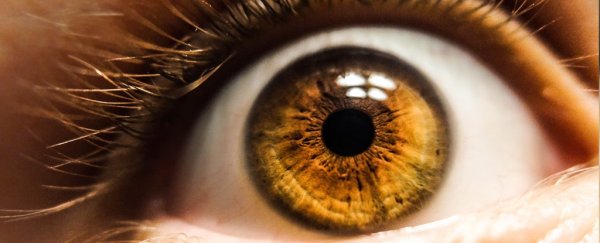Aphantasia is the strange condition where some people are unable to visualize images in their mind. For a long time, aphantasia could only be identified thanks to people's self-reported experiences. Now, we may finally have a way to detect it in a different way.
In this case, the eyes have it. More specifically, in a new study aphantasia could be detected based on pupil dilation response. When the human eye is exposed to bright light, our pupils contract, and when they are exposed to darkness they expand so as to let more light into the retina; however, it's also known our pupils can change size due to cognitive tasks.
Researchers in Australia tested two groups of participants; 42 in one group with self-reported regular visual imagination skills, and another group of 18 individuals with self-reported aphantasia were asked to view images with light and dark shapes on a gray background.
Individuals from both groups showed regular pupil dilation responses to both the light and dark images.
But then the researchers asked both groups to imagine the same images with their eyes open. Curiously, they found that the pupils of individuals with regular visual imagination would still contract and expand, while the pupils of individuals with aphantasia didn't change size to a significant level.
"Our results provide novel evidence that our pupils respond to the vividness and strength of a visual image being held in mind, the stronger and more vivid that image, the greater the pupillary light response," state the authors of the paper.
"Finally, we show that, as a group, there is no evidence of this pupil response in individuals without mental imagery (aphantasia)," they add.
Because the pupil's response to light is involuntary, the study offers a new unbiased measure of aphantasia, since this technique does not rely on self-report.
"We are now close to an objective physiological test, like a blood test, to see if someone truly has it," says lead author of the study, psychologist Joel Pearson from UNSW Sydney.
Additionally, researchers found that people who could imagine more vivid images showed greater pupil dilation. This adds another tool for researchers working to measure strength of mental imagery in further studies.
However, perhaps the most interesting question posed by the study is how mental imagery could be driving involuntary pupil response to begin with.
One interpretation proposed by the authors has to do with the shared top-down mechanisms between visual imagery and perception, where brain regions that interpret visual information process imaginary visuals in much the same way as actual visual data.
In this case, the pupil is responding to imagined luminance similarly to how it responds to retina-based light sources, which supports the findings that the stronger or more vivid your mental pictures, the more 'perception-like' that mental imagery really is.
Researchers also wanted to make sure the participants with aphantasia were really trying to imagine the images in the study, so they included an extra task, where they were asked to visualize four shapes simultaneously, instead of one.
"Our pupils are known to get larger when we are doing a more difficult task," says neuroscience researcher Lachlan Kay from the Future Minds Lab, UNSW.
"Imagining four objects simultaneously is more difficult than imagining just one. The pupils of those with aphantasia dilated when they imagined four shapes compared to one, but did not change based on whether the shapes were bright or dark."
The human ability to form mental images of visual content assists many of the important functions our brains can perform. We do it to retrieve information from our long and short-term memory, we do it when we picture letters and symbols when we are learning a language, and we do it when we navigate or remember where we have been.
For people with aphantasia, the mental world is different – highlighting the truly diverse neurological ways in which we all interact with the world.
The study was published in the journal eLife.
